I love making this butternut squash pasta during the cooler months when I’m craving something hearty and comforting. It’s such an easy and delicious fall pasta recipe!
It comes together in as much time as it takes to roast the veggies. After that, it’s a matter of blending the sauce and tossing it with the pasta.
You’ll love the creaminess of the squash sauce, the saltiness of the pancetta, and the aromatic warmth of the nutmeg. Serve it with some crusty bread, and you’ve got a delicious meal for any occasion!
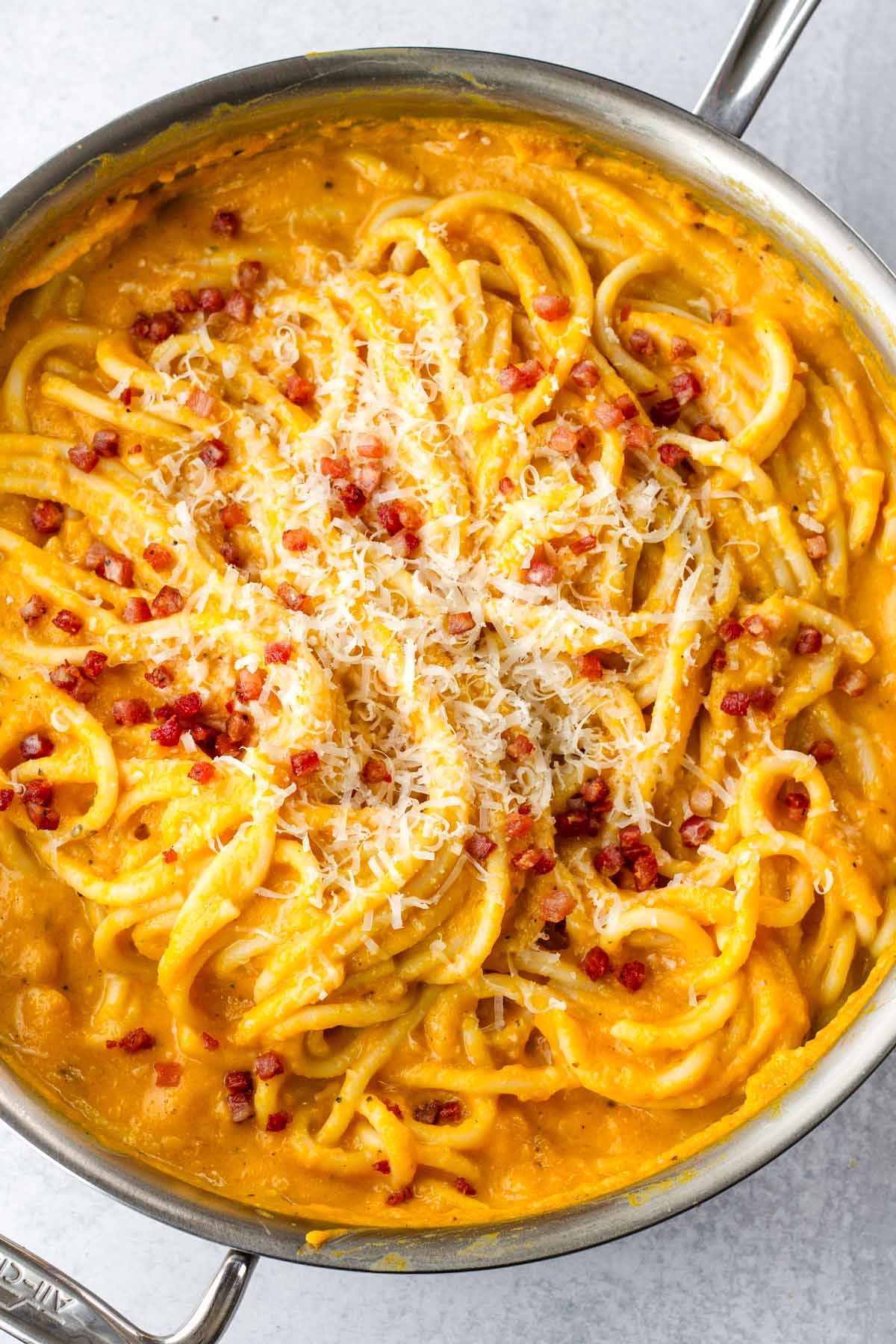
Butternut squash pasta is a deliciously creamy pasta dish, perfect to savor all the wonderful fall produce. I’m all about taking advantage of eating seasonally. One of my favorites is butternut squash!
I love the classics, such as Roasted Butternut Squash Soup and Roasted Butternut Squash and Brussels Sprouts (a classic combo!). And lately, I’ve been using it in slightly more elegant dishes like Butternut Squash Risotto, and today’s recipe, my favorite creamy Butternut Squash Pasta!
It starts with roasting the squash, onions, and a whole head of garlic (you’ll find extra tips on how to roast garlic), and then blending them with broth, milk, and plenty of herbs and spices until creamy and smooth.
Tossed with al dente pasta and little bits of salty crispy pancetta, this fall pasta is an absolutely gorgeous dish!
The hardest part is trying not to eat those beautiful caramelized veggies straight off the tray before you have a chance to blend them. Other than that, it’s super simple to make!
Why I love making this butternut squash pasta:
- Great fall-inspired dish to use up all that beautiful and ripe seasonal produce. It’s cozy and comforting.
- Simple and elegant: It’s quick and easy to whip up to impress your guests, but also simple enough for a casual weeknight meal.
- Tons of flavor: Roasting the veggies ahead of time caramelizes them, delivering even more flavor.
- Rich and creamy: This sauce is smooth and creamy, but not heavy at all.
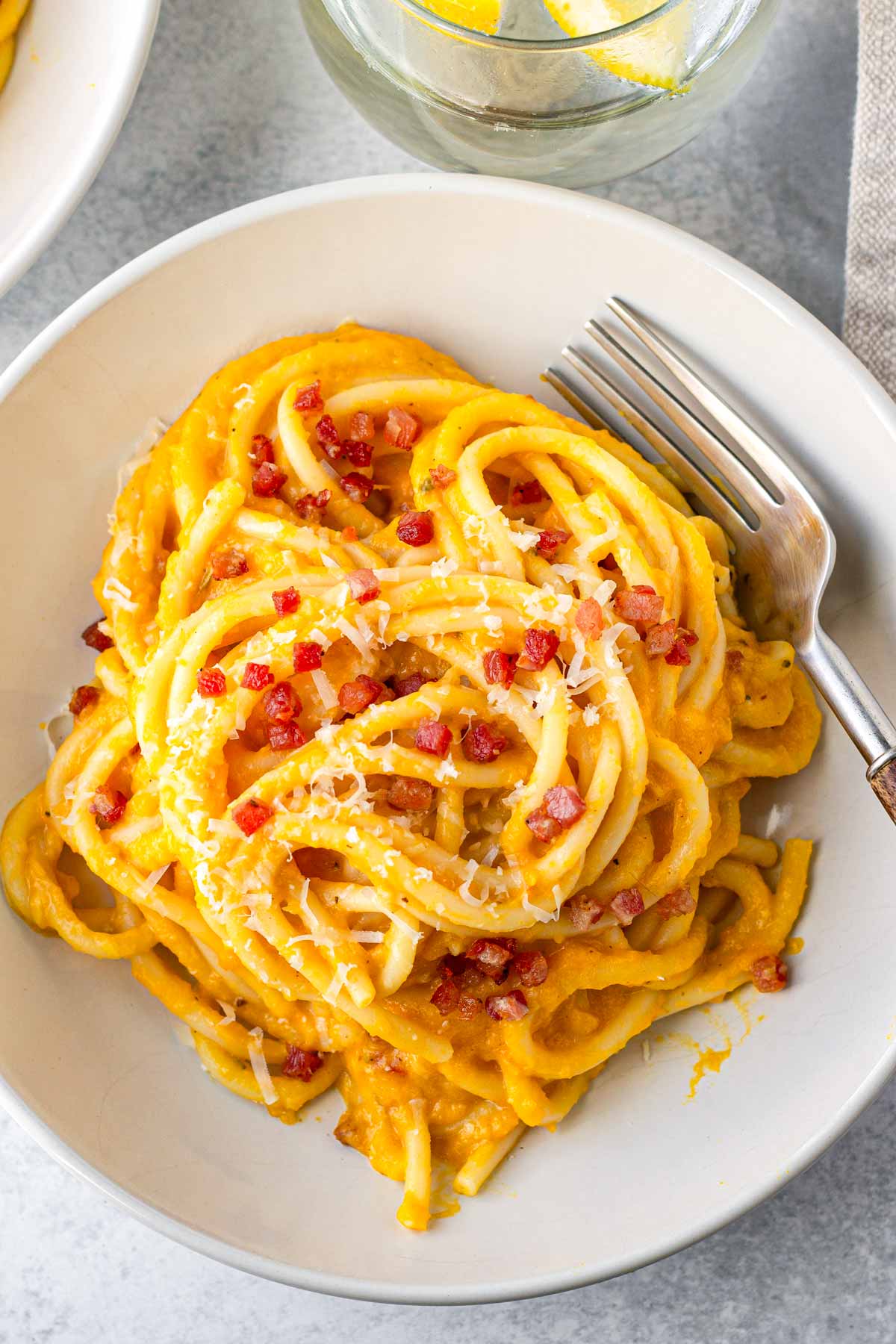
Ingredient Notes
I love this butternut squash pasta as is, but there are plenty of ways to customize it too, so here you’ll find substitutions, as well as a few helpful ingredient notes from recipe testing. As always, ingredient quantities are listed in the recipe card below.
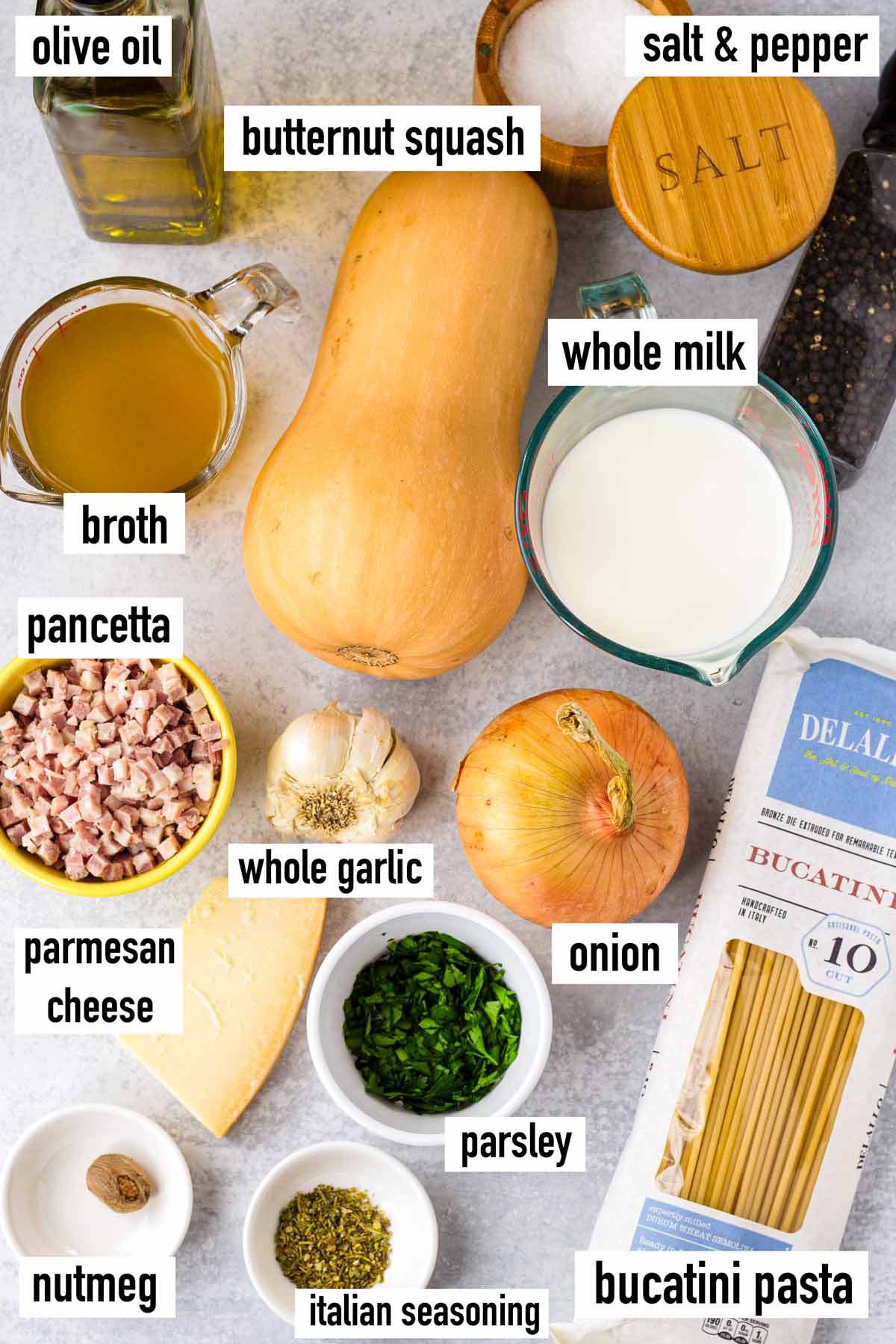
- Bucatini or spaghetti: I like to use thick spaghetti or bucatini, but any type of pasta will work, including short pasta.
- Butternut squash: Peeled and cut into 1-inch cubes.
- Garlic and onion: Keep the garlic bulb whole. It’s easier to roast it that way. Chop the onion.
- Olive oil for roasting
- Diced pancetta: A cured pork that adds a nice salty balance to this dish. I cook the pancetta in a skillet until golden brown and crispy, and use that to top the final dish. You can also use prosciutto or bacon.
- Italian seasoning: Just a bit for added flavor.
- Whole milk: I use whole milk to thin out the sauce while still keeping it creamy and rich. You can also use half-and-half. Try not to use heavy cream (too thick).
- Broth: Use either chicken broth or vegetable broth.
- Grated or ground nutmeg: This warm spice and squash go hand in hand. Adds that hint of cozy flavors. I usually grate a little bit from a whole nutmeg using a zester, or you can also use a pinch of ground nutmeg.
- Salt and pepper to taste
- Grated parmesan cheese: For serving. Can’t leave the cheese out! It’s pasta after all.
- Parsley for garnish, optional.
Step-by-Step Tutorial
Once you’ve chopped your veggies and put them into the oven, you’ve done most of the work! The rest of the time is spent cooking the pancetta and pasta, and blending the sauce. Here’s how I make my butternut squash pasta.
Step 1 | Roast the vegetables
Preheat the oven to 425 degrees F. Roasting root vegetables requires high heat.
Prep the garlic for roasting: Grab the garlic head and cut ¼ inch off the top, leaving the peel on. Place it on top of a piece of foil and add a generous drizzle of olive overtop. Sprinkle salt and pepper, and fold the foil up around the garlic and twist the top to ensure it’s closed. Set that aside.
Place diced squash onto a large baking sheet, and toss with olive oil, salt, and pepper. In another sheet pan, do the same with the onions, and place the wrapped head of garlic on sheet pan with the onions.
Roast for 35 minutes, until soft and caramelized. Keep an eye out for the onions, they may need to leave the party a bit early!

Step 2 | Cook the pasta and pancetta
Meanswhile, cook the pasta in generously salted water until al dente. Reserve 1 cup of the starchy pasta water and drain the rest. Run the pasta under cold water to stop the cooking process.
While you’re at the stove, cook the diced pancetta in a skillet until golden and crispy. They produce their own fat, so there is no need to add any oil.
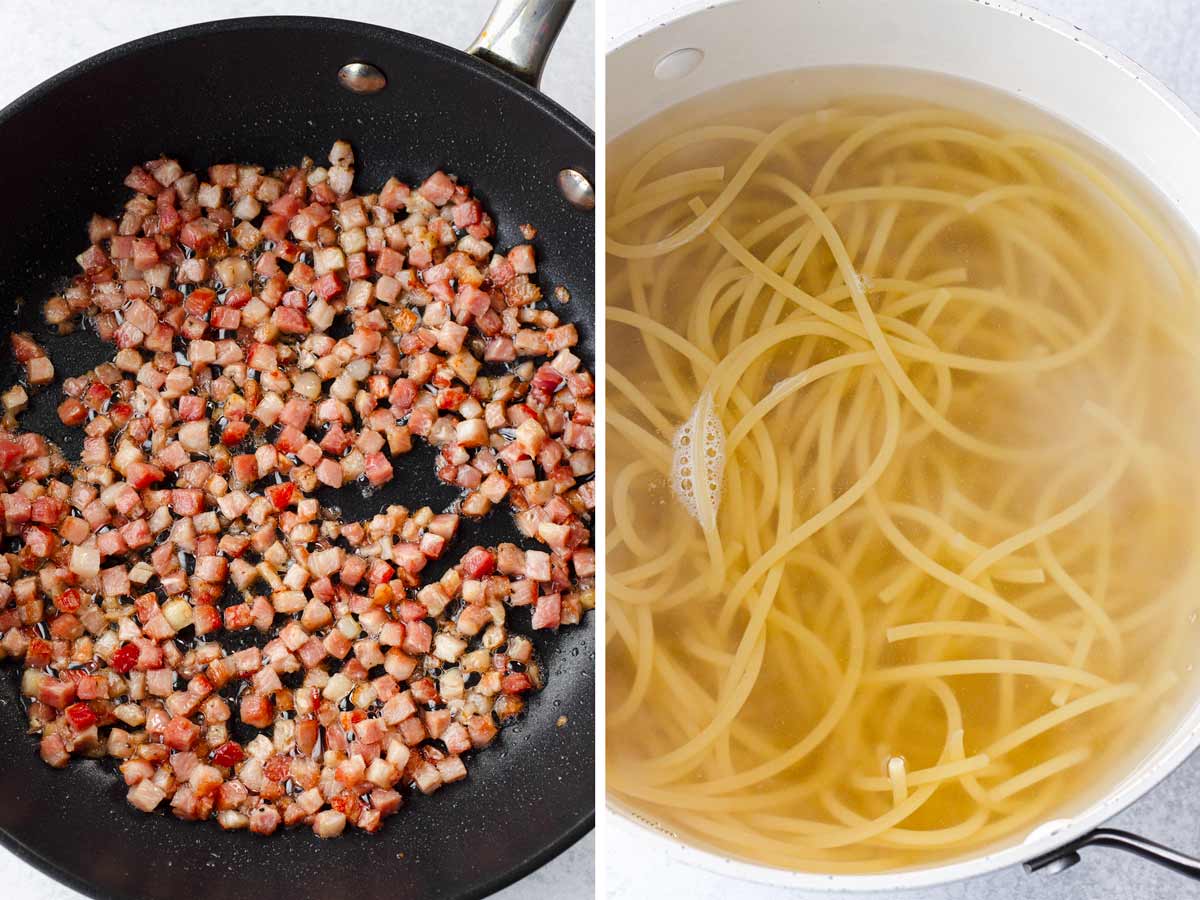
Step 3 | Blend
Transfer the roasted vegetables to a blender (I recommend a good high speed blender for the smoothest results). Remove the foil wrapper, squeeze out the roasted garlic cloves, and drop them into the blender.
Add the milk and broth, and blend until smooth, adding more milk as needed until you get a creamy sauce for the pasta (if your squash was on the larger side, you’ll probably need more liquid).

Step 4 | Toss pasta with sauce
Pour the sauce into a large deep skillet (or the pot from the pasta) and bring it to a light simmer. Add some of the reserved pasta water or more milk to thin it out as needed. Season with the Italian seasoning and salt and pepper to taste.
Add the cooked pasta to the pan and toss to combine. Finish with a pinch of ground nutmeg for those cozy fall flavors.
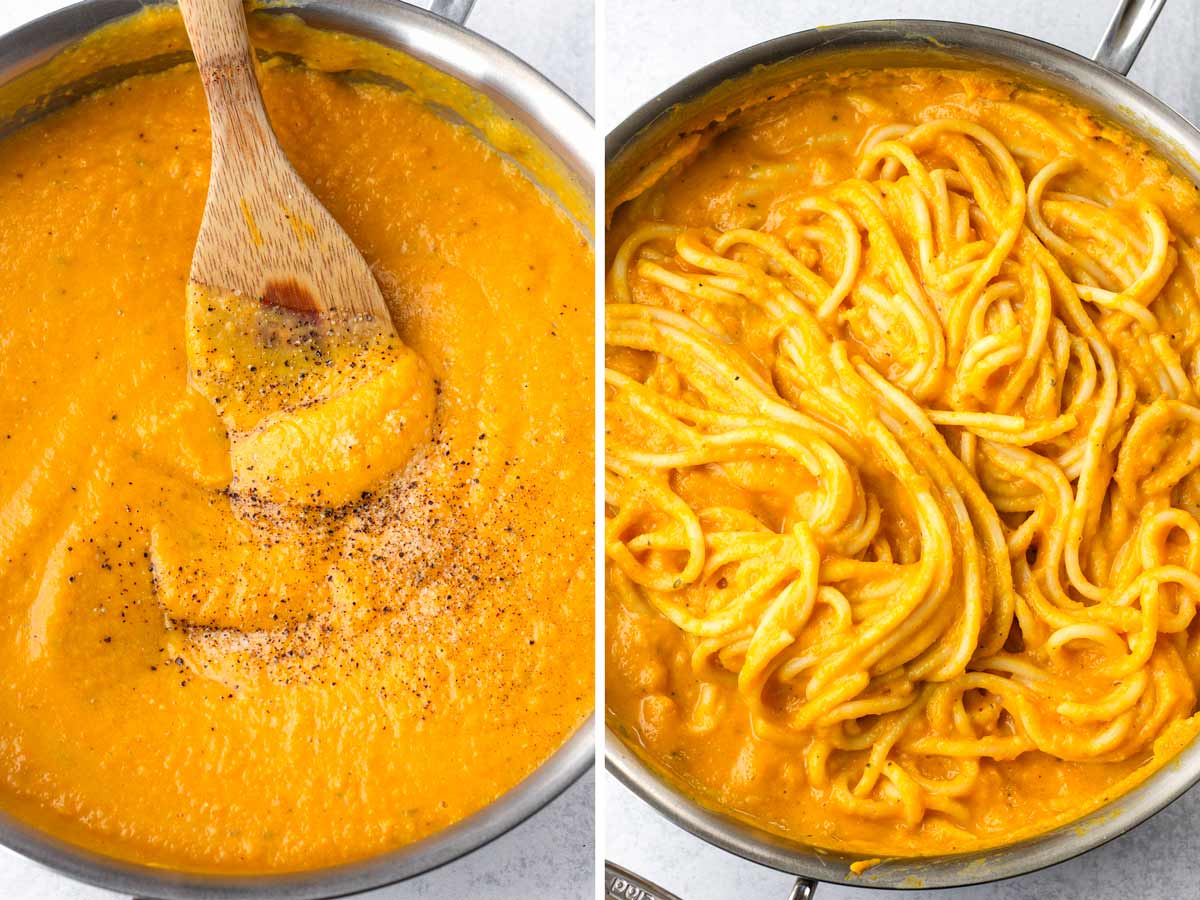
Step 5 | Serve with pancetta and cheese
Serve your butternut squash pasta with the crispy pancetta and freshly grated parmesan on top. If desired, garnish with Italian parsley too. And that’s it! So delicious.

Make Ahead Tips
I prefer to serve this dish freshly made, but if you’re running out of time, you can definitely make this ahead! You can either prep components in advance, or the entire dish. It stores and reheats very well.
There are a few ways to make this butternut squash pasta in advance:
- Roast the veggies ahead of time. Once completely cooled, store them in an airtight container in the fridge and blend the next day when you’re ready.
- Make the butternut squash sauce in advance, and refrigerate it for up to 3 days. When ready to cook, just toss with cooked pasta, along with some pasta water, and also extra broth or milk (the sauce will continue to thicken overnight, so you need to add extra liquid to loosen it up)
- Make it from start to finish. It keeps really well in the fridge. Reheat over the stovetop with a splash of milk to loosen up the sauce.
Pairing and Serving Ideas
Complete your meal with an extra serving of veggies! Serve it with a side of Roasted Cauliflower Salad, Roasted Parmesan Asparagus, or Roasted Parmesan Broccoli.
If you want a more fall-inspired vegetable side, this Sautéed Brussels Sprouts or Warm Brussels Sprouts Salad are both awesome!
You could also serve your creamy butternut squash pasta with my Cheesy Garlic Bread. Having a basket of bread on the table is always a good idea, especially to soak the very last drop of the delicious pasta sauce!
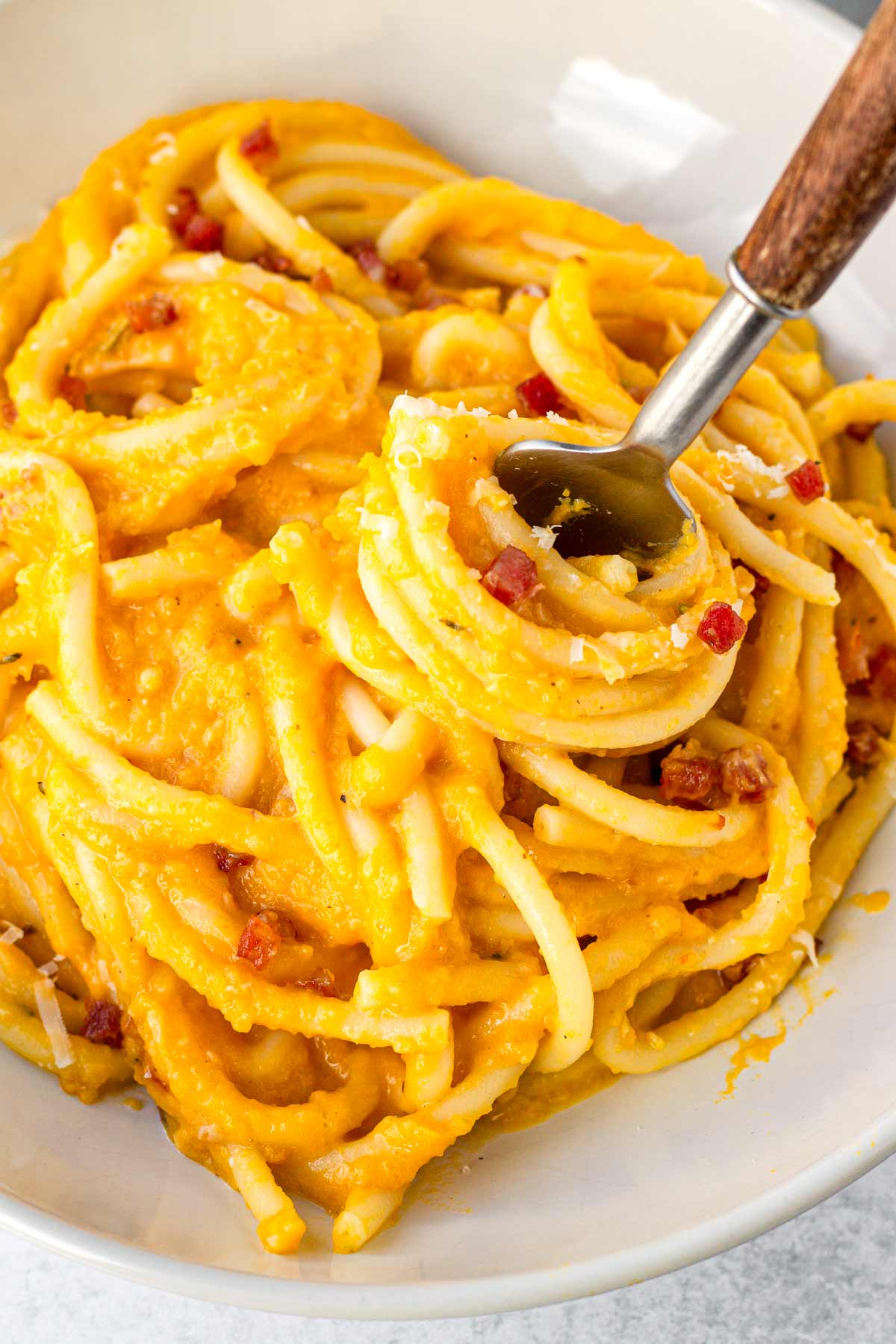
Recipe FAQs
Peel it first using a sharp vegetable peeler (the skin is quite thick). Then, use a sharp knife to cut off the bottom and the tip. Slice the squash in half lengthwise and scoop out the seeds before cutting it into pieces. As a shortcut, you can also buy it pre-diced at the grocery store.
Add more milk or half-and-half as needed. Sometimes, if the squash you’re using is on the large side, you’ll need to add more liquid. Do not use heavy cream, as it is too thick.
Use 2 percent milk or half-and-half. Do not use heavy cream (too thick) or skim milk (too diluted). You can also use other types of milk based on your preferences.
Roasting a whole squash takes more time, which means you’ll have to start roasting it before the onions and garlic. The results will be the same, so I’d recommend starting with cubed.
Tips for Success
- Roasting is a great way to bring out amazing caramelized flavors. It takes time, but it’s worth it, especially the roasted garlic! You can even roast everything 1-2 days ahead.
- Don’t overcrowd the roasting pans. Otherwise, they will steam and not roast.
- Use any type of pasta, long or short pasta. Bucatini, spaghetti, pappardelle, linguine, penne, fusilli, and bowties can all be used.
- The amount of milk needed really depends on the size of the butternut squash. Adjust as needed. You can also use half-and-half.
- If you can’t find pancetta, prosciutto or bacon can be used.
- To add a bit of spice, add red pepper flakes to taste.
- Ground nutmeg: It’s a strong spice, so use just a pinch. It adds a cozy type of warmth. If you don’t like nutmeg, you can omit it.
I’d love to hear from you! If you loved my recipe, please consider leaving a 5-star rating and a comment down below. Sign up for my newsletter and follow along on Instagram, Facebook, or Pinterest
Butternut Squash Pasta
Equipment
- Sheet pan need 2
Ingredients
- 1 whole head garlic
- 1 medium butternut squash - peeled and cut into 1-inch cubes
- 1 large yellow onion - chopped
- Salt and pepper
- Olive oil
- 1 pound thick spaghetti or bucatini pasta - or any pasta
- 1 cup pancetta, small-diced
- 2 to 2 ½ cups whole milk - plus more as needed
- 1 cup chicken or vegetable broth
- ¼ teaspoon dried Italian seasoning
- A pinch of ground nutmeg - optional
- Chopped Italian parsley - for garnish, optional
- Grated parmesan cheese - for serving
Instructions
Roast the veggies
- Preheat oven to 425 degrees F.
- Prep the garlic for roasting: Cut ¼ inch off the top of the whole garlic (unpeeled). Place it on an aluminum foil sheet and generously drizzle with about olive oil, ½ teaspoon salt and pepper. Fold up the foil and close tightly. Set aside.
- On a large sheet pan, toss the diced butternut squash with a few generous drizzles of olive oil, salt and pepper. On a separate sheet pan, do the same with the chopped onions, and place the prepared wrapped garlic on the sheet pan.
- Roast for 35 minutes until caramelized and softened, tossing midway through. You may need to remove the onions a few minutes early.
Cook pasta and pancetta
- Meanwhile, cook the pasta until al dente in generously salted water. Reserve about 1 cup of starchy pasta water. Drain and run through cold water to stop the cooking process.
- In a skillet, cook the diced pancetta until golden brown and crispy. Set aside.
Blend the sauce and toss with pasta
- Once the vegetables are done roasting, transfer the butternut squash and onions into a blender. Squeeze out the garlic cloves into the blender. Add the milk and broth, blend over high speed until smooth, adding more milk as needed to make it creamy (some butternut squash are larger, so you’ll need more liquid).
- Transfer the creamy squash mixture to a large skillet (or to the same pot you used to cook the pasta). Bring to a light simmer, and adjust the consistency by adding some of the reserved pasta water or more milk as needed. Season with the Italian seasoning, and salt and pepper to taste. Finish with a pinch of ground nutmeg to taste.
- Return the pasta into the pan and toss until coated with the creamy sauce. Serve with the crispy pancetta and grated parmesan cheese on top. Garnish with parsley, if desired.
Notes
- The amount of milk needed depends on the butternut squash’s size. Adjust accordingly. You can also use half-and-half.
- For flavor and richness, I’d recommend using whole milk or half-and-half.
- Try not to use heavy cream (too thick). The squash mixture will be too heavy and thick. Try not to use skim milk either (too diluted).
- Ground nutmeg is strong, so use just a pinch. It provides a warm, cozy flavor. You can omit it if that’s not your thing.
- Make ahead: You can 1) roast the veggies ahead, 2) make just the sauce ahead, or 3) make the entire dish from start to finish ahead and reheat later.
- Reheating: Reheat over the stovetop or in the microwave oven, adding a generous splash of milk since the sauce will continue to thicken overnight.
- Whole milk: 2 percent milk or half-and-half. Do not use heavy cream (too thick) or skim milk (too diluted).
- Pasta: Any pasta type, whether long or short. Bucatini, spaghetti, pappardelle, linguine, penne, fusilli, and bowties all work well.
- Pancetta: Crispy prosciutto, bacon.
- Parmesan: Pecorino romano.


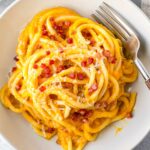
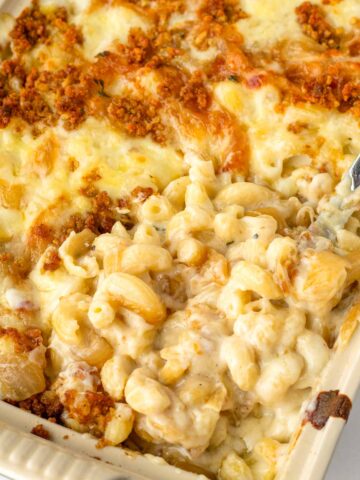
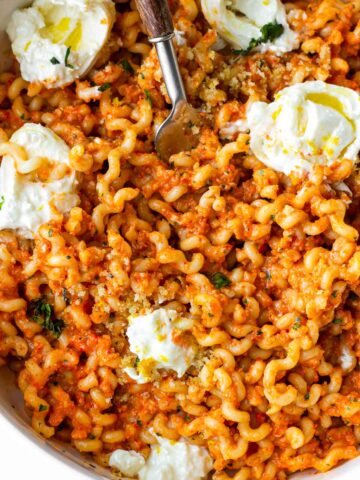
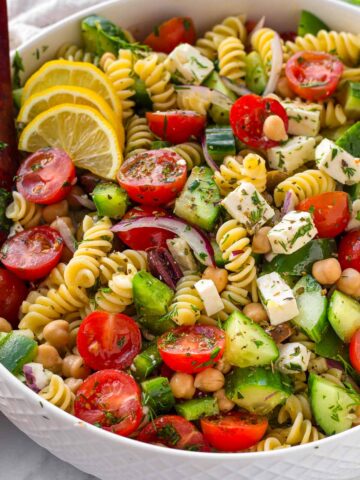


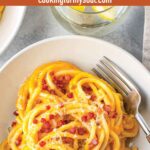
Jovana says
Absolutely delicious! So tasty and easy to make, with beautifully balanced flavours. I’ll definitely make it again!
Tania says
Thank you so much!